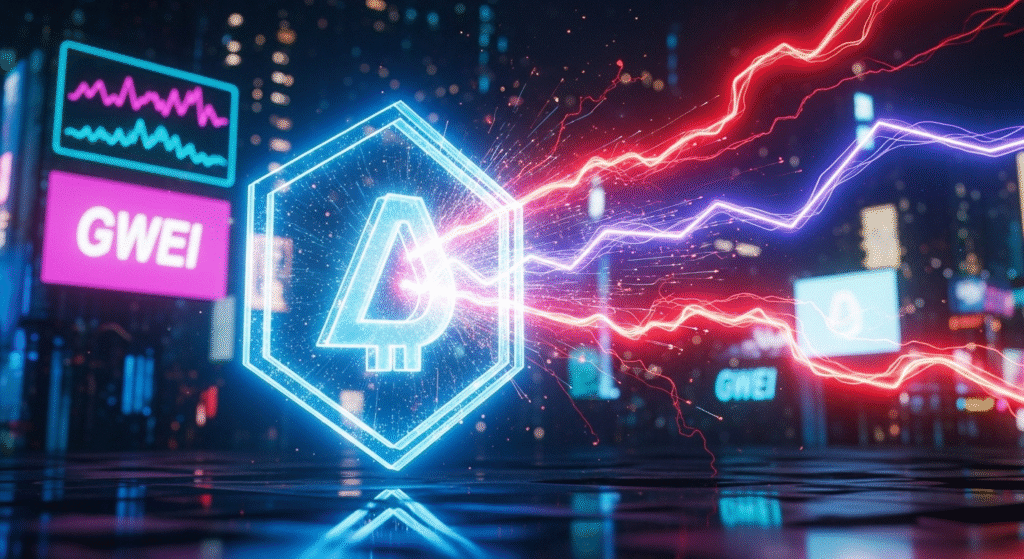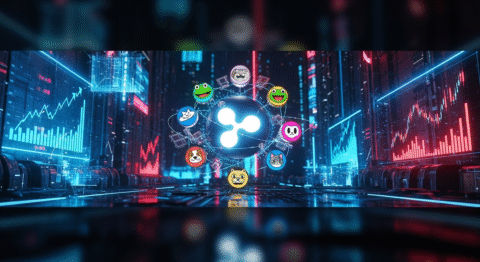Are you tired of watching your hard-earned crypto profits evaporate before they even reach your wallet, simply because of exorbitant Gas Fees?
The cryptocurrency landscape is a vibrant, ever-expanding universe, brimming with innovation and opportunity. From the foundational powerhouses of Bitcoin and Ethereum to the playful, community-driven world of meme coins, there’s an asset for nearly every investment thesis. However, as participation grows, so do the underlying network demands. This is where the often-frustrating reality of Gas Fees comes into play,
Crypto Market Snapshot: A Symphony of Innovation and Volatility
The cryptocurrency market is in a perpetual state of flux, a dynamic ecosystem characterized by rapid innovation, shifting investor sentiment, and the occasional seismic price movement. Currently, we’re witnessing a fascinating interplay of established cryptocurrencies consolidating their positions while an explosion of altcoins and meme coins vie for attention and market share.
Altcoins, broadly defined as any cryptocurrency other than Bitcoin, represent a vast array of projects aiming to improve upon Bitcoin’s limitations or explore entirely new use cases. We see innovative solutions in decentralized finance (DeFi), non-fungible tokens (NFTs), supply chain management, and more. Many of these altcoins offer unique technological advancements and the potential for significant growth, making them attractive to investors seeking diversification beyond the dominant players.
Meme coins, on the other hand, have carved out a unique niche, often born from internet culture and community enthusiasm rather than purely technological innovation. While initially dismissed by some, their ability to generate substantial hype and community engagement has led to impressive, albeit often volatile, price surges. Projects like Dogecoin and Shiba Inu have demonstrated the potent force of community-driven marketing and viral adoption.
Key market indicators at present suggest continued interest in smaller-cap cryptocurrencies, with a renewed focus on utility and technological innovation among altcoins. However, the speculative nature of meme coins means they remain susceptible to large swings driven by social media trends and influencer endorsements. Understanding these dynamics is crucial for anyone looking to interact with these markets effectively and efficiently, especially when considering the impact of Gas Fees on your trading strategy.

The Core Concept: How Swaps and Gas Fees Actually Work
To truly master saving on Gas Fees, it’s essential to grasp the fundamental mechanisms driving these costs, especially as they relate to altcoins and meme coins.
What Are Altcoins / Meme Coins / Airdrops?
Let’s break down the terminology:
- Altcoins (Alternative Coins): This is a broad category encompassing any cryptocurrency that isn’t Bitcoin. They often emerge with specific goals, such as faster transaction times, different consensus mechanisms (like Proof-of-Stake vs. Proof-of-Work), enhanced privacy features, or specialized applications within particular industries. Examples range from established projects like Ethereum (ETH) and Cardano (ADA) to countless newer ventures.
- Meme Coins: These cryptocurrencies are typically inspired by internet memes, social media trends, or humorous concepts. While their origins might be lighthearted, many have cultivated strong communities and are traded actively on exchanges. Their value can be highly speculative, driven by viral marketing and sentiment rather than intrinsic utility, though some are increasingly incorporating DeFi features. Dogecoin (DOGE) and Shiba Inu (SHIB) are prime examples.
- Airdrops: These are promotional events where new cryptocurrencies are distributed to existing holders of a particular crypto or to active users of a specific blockchain protocol, often for free. They are a common marketing strategy to bootstrap a new project, increase token distribution, and build community. Participating in airdrops can be a way to acquire new assets, but often requires interacting with smart contracts, which incurs Gas Fees.
Key Components & Technologies
The underlying technology powering these cryptocurrencies is crucial to understanding Gas Fees:
- Blockchain Technology: At its heart, every cryptocurrency transaction occurs on a distributed ledger known as a blockchain. This ledger is maintained by a network of computers (nodes). When you send a transaction, it’s broadcast to this network.
- Smart Contracts: Many altcoins and meme coins operate on platforms that support smart contracts, most notably Ethereum. Smart contracts are self-executing contracts with the terms of the agreement directly written into code. They automate processes like token swaps on decentralized exchanges (DEXs), NFT minting, and participation in DeFi protocols. Executing these complex operations requires computational resources.
- Miners/Validators: Blockchain networks rely on miners (in Proof-of-Work systems) or validators (in Proof-of-Stake systems) to process transactions, verify them, and add them to the blockchain. This computational effort is rewarded.
- Gas: This is the unit used to measure the amount of computational effort required to execute a specific operation or transaction on a blockchain, particularly on Ethereum and EVM-compatible chains. Think of it as the “fuel” that powers the blockchain. The total Gas Fees are calculated as:
Gas Units (used by transaction) * Gas Price (per unit).
When you initiate a swap on a DEX like Uniswap or PancakeSwap, you’re interacting with a smart contract. This interaction requires computational power from the network validators. You pay in the native cryptocurrency of that blockchain (e.g., ETH for Ethereum, BNB for Binance Smart Chain) to compensate these validators for their work in processing and confirming your transaction. The higher the demand for network resources, the higher the Gas Price, and thus, the higher your Gas Fees.
The Data-Driven Perspective: Unpacking Market Performance and Tokenomics
Understanding the market dynamics and the internal structure of altcoins and meme coins is key to making informed decisions, especially when weighing the cost of Gas Fees against potential gains.
Market Data & Trends
The altcoin market is notoriously diverse. According to data from CoinMarketCap and CoinGecko, altcoins (excluding Bitcoin and Ethereum) often represent a significant portion of the total cryptocurrency market capitalization. Trends we’ve observed include:
- Sector Rotation: Investor interest frequently rotates between different altcoin sectors. For instance, periods of high activity in DeFi are often followed by surges in utility tokens or NFTs.
- Meme Coin Volatility: Meme coins can experience parabolic price movements driven by social media sentiment. A single viral tweet or a celebrity endorsement can lead to massive, albeit often temporary, spikes in value and trading volume. This increased volume on meme coin transactions directly correlates with higher network congestion and thus, potentially higher Gas Fees.
- Airdrop Activity: Airdrops continue to be a popular tool. Tracking historical airdrop data reveals which protocols are actively distributing tokens and which blockchain networks are seeing the most airdrop activity, which could indicate higher Gas Fee environments.
- Network Congestion: Data from blockchain explorers (like Etherscan for Ethereum) clearly shows periods of high network utilization. During peak times, the number of pending transactions can surge, driving up the average Gas Price significantly. For example, during major market events or popular NFT mints on Ethereum, Gas Fees can climb to hundreds of dollars per transaction.
Tokenomics & Market Health
Even for meme coins, understanding tokenomics is crucial:
- Supply & Distribution: Is the token supply fixed, inflationary, or deflationary? How is it distributed? A large portion held by a few early investors can pose a risk.
- Utility vs. Hype: Does the altcoin or meme coin have a clear use case beyond speculation? Projects with genuine utility or strong community governance tend to be more sustainable.
- Staking and Burning Mechanisms: Some tokens incorporate features like staking rewards (incentivizing holding) or token burning (reducing supply), which can influence price dynamics. These mechanics can impact the desirability and therefore demand for a token, indirectly affecting network activity and Gas Fees.
For instance, a meme coin with a very large circulating supply and active trading across multiple DEXs will inherently contribute more to network congestion, leading to higher average Gas Fees for all users on that network. Conversely, altcoins focused on scalability solutions or Layer-2 networks often aim to mitigate these Gas Fee issues.
Risks, Challenges & Competition
Navigating the world of altcoins and meme coins, especially with the added burden of Gas Fees, comes with inherent risks.
Risks of Altcoins and Meme Coins
- Extreme Volatility: Meme coins, in particular, are susceptible to extreme price swings. A community’s sentiment can change rapidly, leading to significant losses. Many altcoins, especially those in early development, also exhibit high volatility.
- Security Vulnerabilities: Newer projects may have less robust security measures, making them targets for hacks and exploits. Smart contract bugs can lead to the loss of funds.
- Rug Pulls and Scams: The anonymity and ease of launching tokens on some blockchains have unfortunately led to an increase in fraudulent projects where developers abandon the project and abscond with investor funds.
- Regulatory Uncertainty: The regulatory landscape for cryptocurrencies, especially altcoins and meme coins, is still evolving. Future regulations could impact their legality and value.
- Gas Fee Inefficiency: As discussed, high Gas Fees can make small transactions or frequent trading uneconomical. If the cost to swap $100 worth of a meme coin is $50 in Gas Fees, it significantly erodes potential profits and discourages participation.
How Do Altcoins / Meme Coins Stack Up Against Competitors?
Let’s consider a hypothetical new meme coin project aiming for broad adoption.
| Feature | Hypothetical Meme Coin (on Ethereum) | Competitor: Meme Coin (on Solana) | Competitor: Newer Blockchain (e.g., Polygon) |
|---|---|---|---|
| Blockchain | Ethereum (EVM) | Solana (SPL) | Polygon (EVM-compatible L2) |
| Transaction Speed | Slower (minutes) | Very Fast (seconds) | Fast (seconds) |
| Gas Fees | High (can be $5-$200+ per transaction) | Low (cents) | Low (cents) |
| DEX Adoption | High (Uniswap, Sushiswap) | Moderate (Raydium, Orca) | High (QuickSwap) |
| Developer Ecosystem | Mature, extensive | Growing, active | Robust, growing |
| Community | Potentially large, viral | Potentially large, viral | Growing |
| Ease of Swaps | Can be costly due to Gas Fees | Cost-effective | Cost-effective |
As the table illustrates, a meme coin project launching on a high-traffic, established blockchain like Ethereum might benefit from wider reach and existing liquidity, but at a significant cost in terms of Gas Fees. Projects on blockchains like Solana or Layer-2 solutions like Polygon offer a stark contrast, providing much lower Gas Fees, making small-cap swaps and frequent trading far more economically viable. This highlights how the choice of underlying blockchain dramatically impacts the user experience and cost of interacting with altcoins and meme coins.
The Future Outlook: Navigating the Evolving Landscape
The future for altcoins and meme coins is inextricably linked to the evolution of blockchain technology and user adoption.
What’s Next for Altcoins / Meme Coins / Airdrops?
- Layer-2 Scaling Solutions: Expect continued migration and innovation on Layer-2 solutions (like Polygon, Arbitrum, Optimism) for Ethereum and other blockchains. These will be critical in reducing Gas Fees and improving transaction speeds, making it much more practical to interact with a wider array of altcoins and meme coins.
- Interoperability: As the blockchain ecosystem matures, expect greater emphasis on interoperability. Projects that can seamlessly communicate and transfer assets across different blockchains will likely gain traction, potentially creating new opportunities for altcoins and meme coins.
- Real-World Utility: While meme coins will likely persist as cultural phenomena, the long-term success of altcoins will increasingly depend on their ability to offer tangible real-world utility and solve actual problems.
- Regulatory Clarity: As governments worldwide grapple with crypto regulation, clearer frameworks will emerge. This could provide a more stable environment for established altcoins but might pose challenges for highly speculative meme coins.
- Airdrop Evolution: Airdrops will likely continue, but projects may innovate their distribution methods to be more targeted, efficient, and perhaps even more cost-effective for participants, potentially reducing the reliance on high-cost swaps.
The quest for lower Gas Fees isn’t just a convenience; it’s a fundamental enabler of widespread adoption for many altcoin and meme coin use cases.
Conclusion: Master Your Swaps, Maximize Your Gains
Navigating the exciting world of altcoins and meme coins doesn’t have to mean battling sky-high Gas Fees. By understanding how these fees are generated, analyzing market trends, and choosing the right blockchain for your transactions, you can significantly reduce your costs. Remember the key takeaways: opt for Layer-2 solutions or more efficient blockchains when possible, be mindful of network congestion, and plan your trades during off-peak hours.
What are your thoughts on managing Gas Fees? Do you have any other clever strategies to share? Let us know in the comments below! For more insights into the dynamic crypto market, explore our other articles on [decentralized finance](link to related article) or [navigating cryptocurrency trading](link to another related article). Don’t forget to subscribe for the latest updates and expert tips to help you thrive in the crypto space!
Frequently Asked Questions (FAQs)
What are the cheapest blockchains for altcoin swaps?
Blockchains like Solana, Binance Smart Chain (BSC), Polygon, Avalanche, and Fantom generally offer significantly lower Gas Fees compared to Ethereum mainnet. Layer-2 solutions built on Ethereum also provide a cost-effective alternative.
Can I avoid Gas Fees altogether?
While you generally can’t avoid Gas Fees for on-chain transactions, you can minimize them by:
- Using more efficient blockchains or Layer-2 solutions.
- Timing your transactions for periods of lower network congestion.
- Batching multiple transactions if a protocol allows.
- Utilizing specific wallet features that help estimate and adjust gas prices.
How do I reduce Gas Fees when claiming an airdrop?
When claiming an airdrop that involves interacting with a smart contract, the Gas Fees are associated with the transaction itself. The best way to reduce them is to choose a blockchain with inherently low Gas Fees if the airdrop is available on multiple networks. If it’s a single-chain airdrop (e.g., on Ethereum), you’ll need to monitor network congestion and potentially time your claim for off-peak hours. Some airdrop claim interfaces might also allow you to adjust the gas limit, but it’s risky if you’re not experienced.
Is it worth paying high Gas Fees for small altcoin trades?
Generally, no. If the Gas Fees exceed a significant percentage of your trade value (e.g., more than 5-10%), it’s usually not economically viable. It’s better to wait for lower Gas Fees, consolidate your trades, or use a more cost-effective blockchain.
How do meme coin pumps affect Gas Fees?
When a meme coin experiences a rapid price surge (a “pump”), it often leads to a massive increase in trading volume. This heightened activity on decentralized exchanges and other protocols, particularly on networks like Ethereum, causes network congestion. As more users try to capitalize on the pump or escape before it crashes, they bid up the gas price, leading to substantially higher Gas Fees for everyone on that network. Anyone looking to buy or sell the meme coin during such a frenzy will likely face these inflated Gas Fees.






